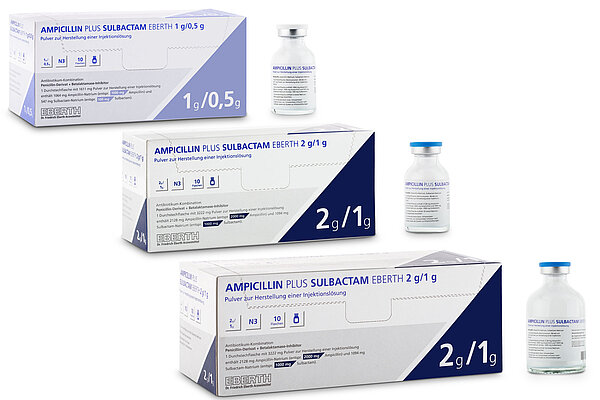Ampicillin plus Sulbactam Eberth
Powder for solution for injection
Ampicillin plus Sulbactam Eberth
Active substances:
Ampicillin sodium + Sulbactam sodium
Pharmacotherapeutic group:
Ampicillin is a semi-synthetic, non beta-lactamase-resistant aminopenicillin. Sulbactam is a beta-lactamase inhibitor with a structure similar to that of ampicillin and other penicillins.
ATC code: J01CR01
Mechanism of action:
The mechanism of action of ampicillin is based on suppression of bacterial wall synthesis (in the growth phase) via blockade of the penicillin-binding proteins (PBPs) such as the transpeptidases. This results in a bactericidal action.
In combination with sulbactam, the inactivation of ampicillin by certain beta-lactamases is inhibited. Sulbactam protects ampicillin from degradation by most beta-lactamases of staphylococci and several plasmid-encoded beta-lactamases (e.g. TEM, OXA, SHV, CTX-M) and certain chromosomally encoded beta-lactamases of Gram-negative bacteria. These beta-lactamases are present in, for example, Escherichia coli, Klebsiella spp., Proteus mirabilis and Haemophilus influenzae. The antibacterial spectrum of action of ampicillin is broadened to include bacteria whose beta-lactamases are inhibited by sulbactam.
Therapeutic indications:
Ampicillin plus Sulbactam Eberth is indicated in the treatment of the following infections in adults and children:
- Severe infections of the throat, nose and ear (such as mastoiditis, peritonsillar infections, epiglottitis and sinusitis with associated severe systemic signs and symptoms)
- Acute exacerbations of chronic bronchitis (after adequate diagnosis)
- Community-acquired pneumonia
- Urocystitis
- Pyelonephritis
- Skin and soft tissue infections, especially cellulitis, animal bites, severe dental abscesses with spreading cellulitis
- Bone and joint infections, especially osteomyelitis
- Intra-abdominal infections
- Female genital infections
Prophylaxis of infections associated with major surgery in adults, such as:
- in the stomach and intestinal tract
- in the pelvic cavity
- on the head and neck
- in the biliary tract

